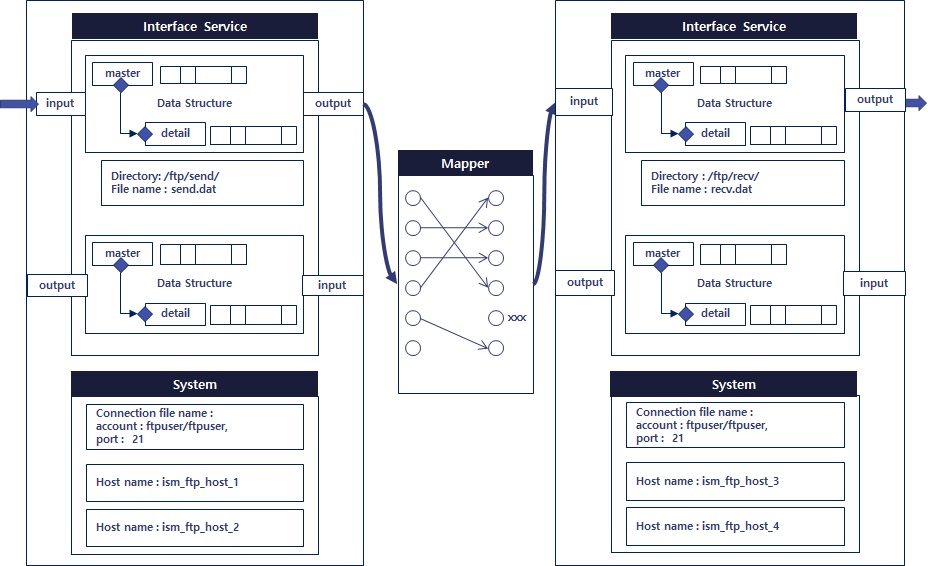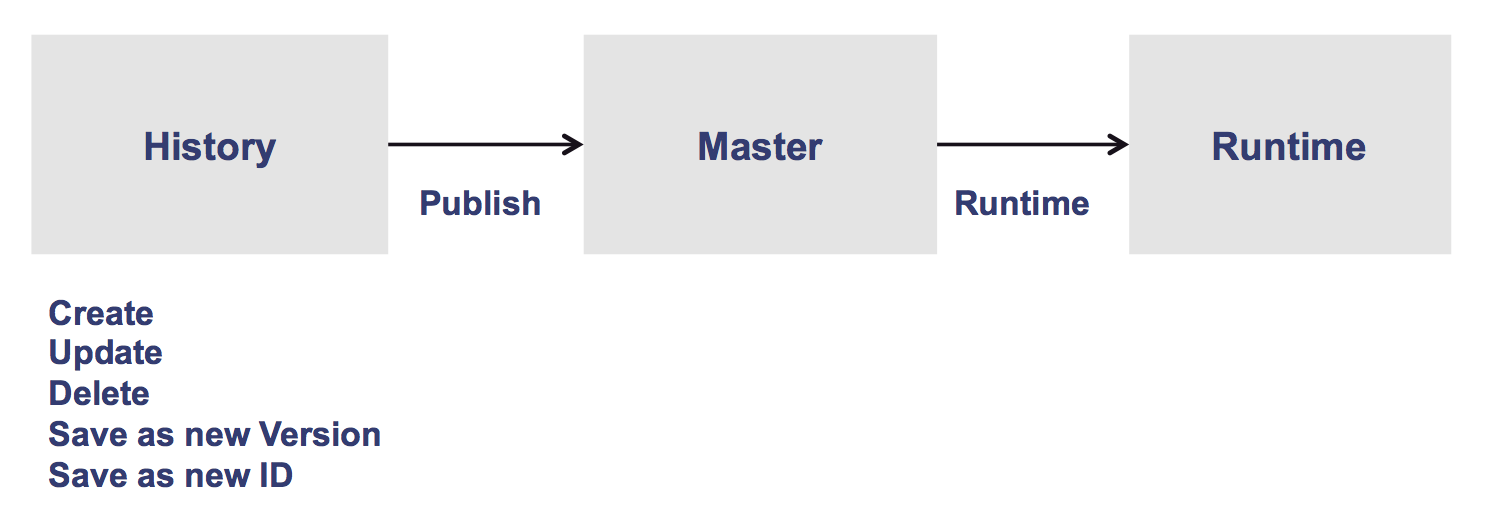

Integration service defined and used in ISM contains all information for integration: the way to send/receive data between the source to target systems, data types, the procedure of the data process, and access way to system. Integration service is a consolidated object with multiple levels of information, which is used in runtime in the ISM process. The integration service object on runtime is specifically called "rule".

Requisite information for integration service among systems can be categorized to system, data, interface service, mapping. For example, file batch service flow is below.
Manage the information of physical server machine. Manage hostname or ip using iSM.
Manage the connection information according to application types. The information varies to application types; file and DB type both requires user account information, specific type of application(e.g. socket) requires port information. The picture below shows the required type of information to approach to the DB type of application.
DB type also should describe not only DB name but also DB server according to DBMS types.
System is the combination of application and server. The number of combination is usually same with server count. If same business application may run on multiple servers, the number of combination is same with server count. If multiple instances of same business application run in one server, that number of combination is application count * server count. This configuration is often used for web server.
System could have proxy server which substitutes the interface between source and target system on runtime. If connection information should be fixed on a program or component - mainly DBMS - besides there, the connection information can be connected dynamically to the source system and the target system. The systems can be connected in dynamic combinations is to be processed by common predefined alternative system.
Proxy system is used only in BusinessWare version.
Proxy systems are used for these types interfaces.
Defines data source system to target system or target system to source system in return. Data is comprised a combination of specific group of fields
Field is used for minimal object to build data. Field is a unit of field group managing the information of length, number, character, date, and format.
Field Group is a combination of fields. It defines the order the field appear and manage the way the field is used in the field group - the status of key field, input and output type.
Field group manages individual field delimiter or length.
Data structure is a combination fo field groups. Data structure comprise of master and detial. Master is the field group repeated only once, detail is the field group repeatable multiple times. Data structure is made up more than one master. Each master can have at least one detail. The configuration methods per data type are as follows.
| Service Method | Data Structure Configuration | Description |
|---|---|---|
| ISM Message | N Master – N Detail | If it is comprised of header and data, contingent on the repetition of data division, Master(header division) + Master(data division) Master(header division) + Detail(data division) Master(header) + Master(data division unrepeated) + Detail(repeated data division) |
| XML message | XML | Compose it to XML expressible structure.
On data structure definition, do not us XML Schema or DTD. |
| 파일 | 1 Master | File data is comprised of a single master. |
| Table | 1 Master | Table data is comrised of a single master. If the data is referred with multiple tables joined, the data structure is composed the joint results as a field group. |
Service is classified to the interface service defining required data and interface type, and the integration service combining interface services.
Manage required data or data extracting or applying method. The batch service transferring file must define the information of file data structure, the file direction, the procedure when the file exist, and then the after transfer procedure(e.g. file authorization change). The data structures used in interace service are input, output, error. How to use each data structure is as follows.

Data transfer from the source to the target can be expressed to request, the opposite can be expressed to response. When target system returns processing result, there's an error process data included and the error process doesn't correspond to the normal process data, it could be expressed error response.
Interface service manages the way how to bring the data or apply them. In general online service, the processing object data is included in the message requested, but only the condition to the process or the service delimiter is included in batch/deferred type. Therefore, for the interface service which is used on batch/deferred, manage the way of extracting/applying data. The picture down below defines the way to bring the data from DB source interface service.
When any conversion is required, define the conversion using input and output data.
Interface service does manage how to take the data or apply them, but it doesn't manage how to from integration service. Whole process flow(rule) is managed in integration service.
The integration service defines the routing condition between two services, the source interface and the target interface and, by extension, manage the target system.
Data managed by ISM is composed of two types. The first is a history data with version information, another is a master data without version information. When on runtime or referring another item there should be a data on master field. For example, there must be at least an application and a server to compose a system. To do so, application and server information on history field has to be in master field.

All the data of ISM has no direct class relationships. The system needs application and server information, but the system has none of them but only the connection information. Each data exist individually and applied separately. For instance, If the IP address of the server, there' no need to modify the system information but only the server information.